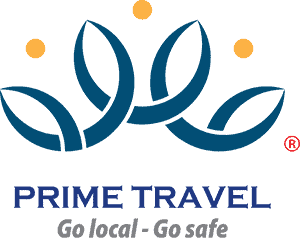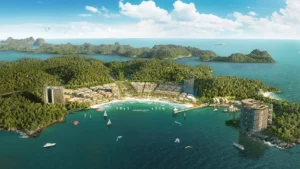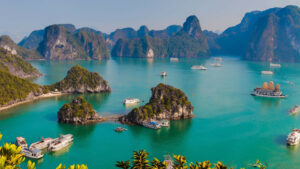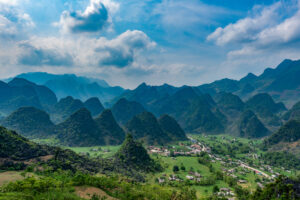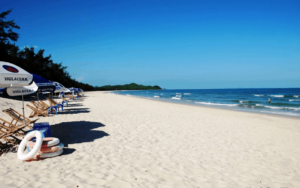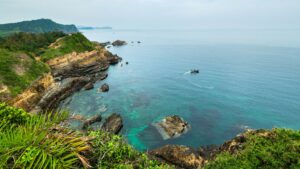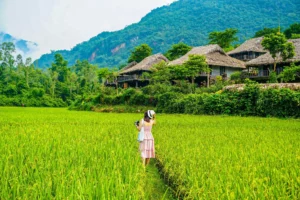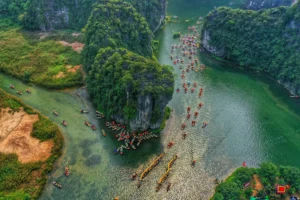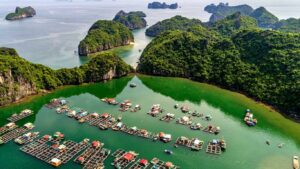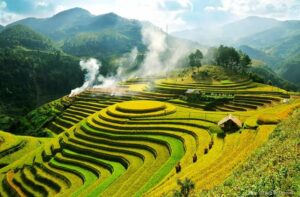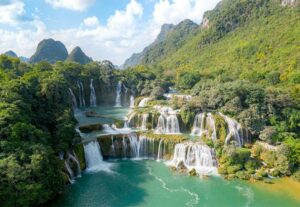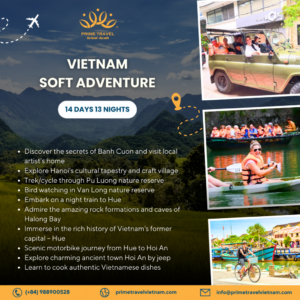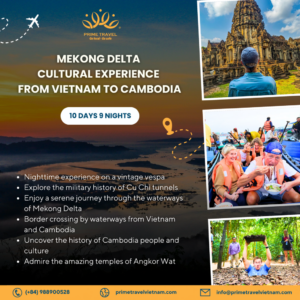
Escape the Heat: 10 Best Summer Destinations in Northern Vietnam
Looking for the perfect way to beat the heat and enjoy a unique travel experience? Northern Vietnam offers a refreshing escape with its cool mountains, lush valleys, and stunning coastal gems. Whether you’re a nature lover, a culture enthusiast, or simply need a scenic getaway, this region has something for every kind of traveler.
In this guide to the best summer destinations in Northern Vietnam, Prime Travel will help you discover where to go, what to expect, and how to make the most of your trip.
From world-famous bays to off-the-beaten-path villages, this article will take you through the highlights of summer travel in Northern Vietnam — including helpful travel tips at the end.
Is Northern Vietnam Good to Travel in Summer?
Overview of summer months
Northern Vietnam features a tropical monsoon climate, with distinct seasonal variations. North Vietnam is divided into 4 seasons: spring, summer, autumn, and winter. Each season has its own beauty to explore.
Summer, spanning from May to August, is characterized by hot, humid conditions and occasional rainfall. The warmest months are typically June and July, where daytime temperatures frequently reach between 30°C and 38°C (86°F–100°F).
However, the region can be divided into two sub-regions with slightly different summer patterns: the Northeast and the Northwest. The Northeast—home to destinations like Ha Long Bay and Ha Noi—tends to have higher humidity and more rainfall due to its proximity to the Gulf of Tonkin.
Summer in this region often lasts from May to September and comes with hot, humid weather, accompanied by the region’s highest rainfall. The hottest and wettest months are usually June, July, and August.
Meanwhile, the Northwest—featuring areas such as Mai Chau and Sa Pa—is mountainous and often experiences slightly cooler temperatures and less humidity due to its high altitude. The weather here can be cooler than Northeast cities and provinces, making it a perfect escape from the heat of big cities.
Despite the heat, the region’s natural beauty peaks during this period. The countryside bursts with green rice paddies, tropical fruit harvests, and floral blooms. While rainfall increases in July and August, showers are often short-lived and provide a refreshing contrast to the high temperatures.
Read more>>>Vietnam Weather By Month: 12-Month Guide for Travelers’ Best Trip
Advantages and Disadvantages of Northern Vietnam Summer Travel
Before planning your summer travel in Northern Vietnam, it is important to consider both the benefits and the challenges. The region offers a variety of landscapes and seasonal highlights that appeal to many types of travelers.
Advantages:
- Coastal destinations such as Cat Ba and Co To offer stunning beaches, ideal for relaxation and water activities.
- Highland areas like Ha Giang and Pu Luong provide cooler temperatures and excellent trekking opportunities.
- Summer brings vibrant cultural events and an abundance of tropical fruits that enhance the local experience.
- The best time to admire the ripe rice fields of Northern Vietnam.
Disadvantages:
- The intense heat and humidity can be tiring, especially for those unaccustomed to tropical climates. I have seen so many healthy, well-built foreign pals get sunstroke participating in outdoor activities in Vietnam.
- July and August see higher tourist volumes due to school holidays, leading to crowded attractions and limited availability.
- Sudden rain showers may affect travel plans, though they are usually short-lived and predictable.
- Airfare prices go up due to the peak travel season.
Why Visit Northern Vietnam in Summer?
Visiting Northern Vietnam in summer offers travelers a unique way to experience the region’s vibrant landscapes and rich cultural life. While some may hesitate due to the warmer weather, this season opens up access to a variety of outdoor activities, scenic vistas, and authentic encounters.
From the cool, misty hills of the Northwest to the sun-soaked islands of the Northeast, summer destinations in Northern Vietnam cater to all interests. Nature lovers can trek through lush rice terraces or cruise emerald bays, while culture enthusiasts can explore historic towns and enjoy traditional festivals. The seasonal fruits, local delicacies, and hospitality of the people further enhance the travel experience.
Besides, traveling in Northern Vietnam, you can avoid the crowd because local people often head to the central region for a beach vacation during this period. Ultimately, summer in Northern Vietnam is not just about beating the heat—it’s about immersing yourself in a destination at its most dynamic and colorful time of year.
To get a better insight of traveling in Vietnam during summer, read our blog Ultimate Vietnam Summer Travel Guide.
Top Summer Destinations in Northern Vietnam
Northern Vietnam offers many stunning landscapes suited for every kind of traveler. From coastal escapes and mountain retreats to island getaways and cultural heartlands, the region promises both adventure and tranquility. Whether you’re seeking natural beauty, cultural heritage, or peaceful relaxation, these locations capture the essence of summer travel.
Ha Long Bay
Ha Long Bay is one of the most iconic summer destinations in Northern Vietnam. Famous for its emerald waters and towering limestone karsts, the bay is ideal for cruising, kayaking, and swimming. Summer offers longer daylight hours, perfect for exploring hidden caves and fishing villages. It also means a greater chance to admire stunning sunrises and sunsets on the bay.
Despite occasional rain, Ha Long Bay remains a favorite for its scenic charm and diverse activities. Overnight cruises are especially popular, offering the chance to admire sunrise and sunset over the tranquil waters. For nature and photography enthusiasts, it’s a must-visit during the warmer months.
Read more>>>Visit Vietnam In July – Weather, Traditional Festival and Best Places To Visit 2025
Ha Giang Loop
The Ha Giang Loop, without a doubt, was a hidden gem in Vietnam. Although it has been going viral lately and has become a go-to destination for adventurous travelers, the service and the scenery here are still worth the hype.
The Ha Giang Loop offers dramatic landscapes and a taste of authentic Vietnamese culture. Located in the far north, this mountainous route winds through limestone peaks, terraced fields, and remote ethnic villages.
The cooler mountain air is a welcome escape from the lowland heat, and summer adds a lush vibrancy to the scenery. Motorbike tours are the most popular way to experience the loop, though guided tours are available for added convenience and safety.
Just note in mind that you should check the weather forecast beforehand because downpours can happen quite frequently during the summer.
Quan Lan Island
Tucked away in Bai Tu Long Bay, Quan Lan Island offers a quieter alternative to more popular coastal spots. Its pristine beaches and calm waters make it a perfect summer destination for those who like traveling off the beaten path.
The island maintains its traditional fishing village charm and is less developed, giving visitors a more authentic and peaceful experience. Activities include biking, beachcombing, and exploring local temples and seafood markets.
Cat Ba Island
Cat Ba Island, located just to the south of the world-famous Ha Long Bay, is one of the best destinations in Northern Vietnam for beach lovers. It is known for its mix of forested hills, sandy beaches, and marine biodiversity.
Summer is the best time to enjoy swimming, boat tours, and hiking in Cat Ba National Park to reach Viet Hai Village. The island also offers various accommodations, from hostels to upscale resorts, making it suitable for all travel styles.
Visitors can also take a boat to explore Lan Ha Bay or go rock climbing on the limestone cliffs. With its balance of nature and comfort, Cat Ba is a perfect summer base for both adventure and relaxation.
Co To Island
Co To lies in the far eastern part of Quang Ninh Province, around 80 kilometers from the mainland. This island district comprises nearly 50 islets, with Co To, Co To Con (Little Co To), and Thanh Lan being the primary clusters that attract visitors.
The island is known for its crystal-clear waters and laid-back atmosphere. Just one and a half hours going by speedboats, it’s ideal for a beach vacation far from the bustling city life.
During summer, visitors can enjoy sunbathing, snorkeling, and boat rides around the archipelago. The island is also home to picturesque lighthouses and unspoiled beaches like Hong Van and Van Chay.
Fewer crowds and well-preserved nature make Co To an excellent destination for families and couples. Don’t miss a visit to the Co To lighthouse for panoramic views of the sea and nearby islets.
Mai Chau
Surrounded by mountains and rice fields, Mai Chau is a tranquil valley perfect for cultural immersion. Home to several ethnic minorities, it offers homestays, cycling tours, and scenic hikes.
Summer brings a green landscape and active village life, ideal for travelers who wish to experience local traditions. Cooler evenings and light breezes make it a refreshing escape from the heat.
Guests can participate in kayaking on the Hoa Binh Reservoir, traditional dances, taste home-cooked meals, or visit nearby waterfalls. A full-day trekking tour in Pu Luong Nature Reserve nearby is also worth trying for nature lovers. The peaceful rhythm of daily life in Mai Chau offers a meaningful retreat into Vietnamese culture.
Ninh Binh
Ninh Binh is often called “Ha Long Bay on land” due to its limestone karsts and winding rivers. The area is rich in history, with ancient temples and pagodas scattered throughout.
Boat tours through Tam Coc or Trang An are highlights of any summer itinerary. The lush scenery and cultural landmarks provide a fulfilling and relaxing travel experience.
In addition to boat rides, visitors can climb Hang Mua for panoramic views, explore ancient Hoa Lu, or cycle through the countryside. Ninh Binh perfectly combines nature, history, and spirituality.
Lan Ha Bay
Adjacent to Ha Long Bay, Lan Ha Bay offers a similar landscape with fewer tourists. Its calm waters and limestone cliffs make it perfect for kayaking, swimming, and relaxing on secluded beaches.
Lan Ha Bay is especially recommended for travelers who want to avoid the crowds while still enjoying the natural beauty and marine adventures Northern Vietnam offers in summer.
The area features hidden lagoons and floating villages, and it’s common to spot local fishermen at work. Overnight cruises provide a peaceful experience, with starry skies and the gentle lull of waves.
Pu Luong
Want to explore Sa Pa, but you are not a fan of crowded places? Try Pu Luong – a hidden gem with terraced rice fields, dense forests, and ethnic Thai villages. It’s a favorite for eco-tourism and trekking enthusiasts.
During summer, the fields are lush and green, and the weather is cooler than in the lowlands. Guided hikes, homestays, and cultural exchanges make it a unique summer travel experience.
With fewer crowds and a slower pace of life, Pu Luong offers meaningful interactions and natural tranquility. It’s perfect for travelers seeking sustainability and a break from modern distractions.
Read more>>>Top Things To Do In Pu Luong Nature Reserve
Ba Be National Park
Located in Bac Kan Province, Ba Be National Park is home to one of Vietnam’s largest freshwater lakes and is surrounded by limestone mountains, lush tropical forests, and diverse wildlife. It’s a paradise for nature lovers and adventure seekers.
In summer, the park is vibrant and full of life. Visitors can explore caves, take boat rides, and visit local ethnic communities. The cooler climate and abundant nature make Ba Be an excellent retreat from city heat.
Birdwatching, kayaking, and staying in stilt-house homestays offer a well-rounded experience of Northern Vietnam’s biodiversity and rural life. The park’s peaceful atmosphere makes it ideal for a rejuvenating summer holiday.
Travel Tips for a Smooth Summer Trip
Planning a summer trip to Northern Vietnam can be incredibly rewarding, especially with the right preparation. To ensure a smooth and enjoyable journey, consider these essential travel tips—from what to pack to cultural etiquette. Being well-prepared helps travelers avoid common pitfalls and fully enjoy their time exploring the region.
What to Pack for Summer Travel
Given the heat and humidity, pack lightweight, breathable clothing made from natural fabrics like cotton or linen. Bring a wide-brimmed hat, sunglasses, and high-SPF sunscreen to protect against strong UV rays. A light raincoat or umbrella is also essential, as summer showers are frequent.
If you plan to do any outdoor activities or hiking, footwear should be comfortable and suitable for walking or hiking, especially in rural or mountainous areas. Insect repellent, reusable water bottles, and a small medical kit with essentials like electrolyte tablets are highly recommended for added comfort and safety.
Moreover, we also recommend starting your day early to enjoy cooler mornings and avoid taking part in outdoor activities during peak sun hours (11 AM – 3 PM). Stay hydrated and stay safe. Check the weather forecast regularly to avoid traveling under bad weather conditions.
Transportation Tips
Public transportation is widely available in Northern Vietnam, with options ranging from buses and trains to domestic flights. Booking intercity transfers in advance during the busy summer season ensures smoother travel and better prices.
For regional travel, consider hiring a private car or joining a guided tour for added convenience and local insight. In rural areas, motorcycles and bicycles are great for short distances, but always wear helmets and exercise caution.
Read more>>>Hidden Gems of Vietnam – Top 10 Off the Beaten Path and Local Experiences
Budgeting Advice
Summer is a popular travel season, so prices for accommodation and tours may increase, especially in well-known destinations. To stay on budget, book flights and hotels early, and explore less-touristy areas that offer better value.
Set a daily spending limit and keep small cash handy, as many rural places don’t accept cards. Street food and local eateries are both affordable and delicious, making it easy to enjoy authentic cuisine without overspending. But you should keep an eye on the food stall, and walk away if you notice anything unsanitary and unsafe to eat.
Cultural Etiquette & Safety Tips
Respecting the local culture plays a big role in creating positive travel experiences. When visiting temples or ethnic villages, wear modest clothing that covers your shoulders and knees. Always ask for permission before taking photos of locals, especially in traditional communities.
A warm smile, patience, and polite body language help foster mutual respect. Learn a few Vietnamese phrases or greetings—it goes a long way in building rapport with locals.
In terms of safety, avoid drinking tap water and stick to sealed bottled water or use a portable purifier. Keep personal belongings secure, particularly in busy markets or on public transport. For outdoor excursions, apply sunscreen regularly and stay hydrated throughout the day. During hikes or rural visits, let someone know your travel plans and be aware of emergency contacts or local clinics nearby.
Highly recommend Vietnam tours in Summer
14-Day Cultural and Culinary Journey Through Vietnam
14-Day Vietnam Soft Adventure
10-Day Mekong Delta Cultural Experience from Vietnam to Cambodia
>>>>>Explore more>>>>>>>
Travel to Vietnam from Philippines: Best Tours and Travel Information 2025
Vietnam Tours From Australia: Best Tours And Holiday Packages 2025
